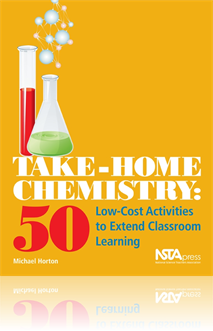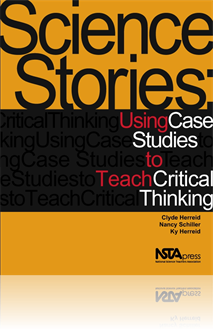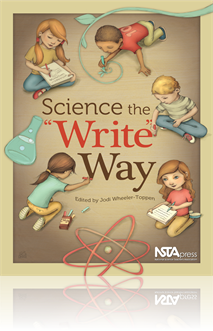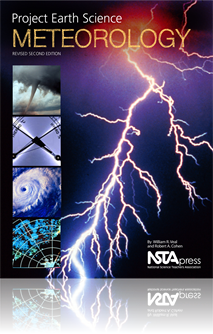All Book Chapters
Book Chapter
Average Atomic Mass Simulation
In this activity, students will use a large number of small objects to find the average mass of the objects....
Book Chapter
In this activity, students will dissolve pieces of Alka-Seltzer tablets in water after crushing them and heating the water, and then time how long the reaction takes to complete....
Book Chapter
Molecular Motion and Temperature
In this activity, students will see how the rate of diffusion varies in cold, room temperature, and hot water....
Book Chapter
In this activity, students will make warm water boil by reducing the pressure inside a syringe...
Book Chapter
Lifting an Ice Cube With a String
In this activity, students will lift an ice cube by sprinkling salt over a string on the ice....
Book Chapter
In this activity, students will construct molecules out of papers they cut out to determine the chemical formula and the method for writing chemical formulas....
Book Chapter
In this activity, students will use their ion pieces to simulate the finishing and balancing of chemical equations....
Book Chapter
In this activity, students determine which of three variables affects the period of a pendulum....
Book Chapter
Identifying Types of Streetlights Lab
In this activity, students will build an apparatus that will allow them to see the spectrum created by different streetlights....
Book Chapter
In this activity, students will grow crystals of sugar, sodium chloride, and Epsom salts....
Book Chapter
In this activity, students will decompose water by running electricity through inert conductors....
Book Chapter
In this activity, students will judge the solubility of three solids and three liquids....
Book Chapter
In this activity, students will learn whether or not ice formed on the surface of ice water is salty....
Book Chapter
In this activity, students will create an “invisible ink” and then test to see which chemical may be responsible for making it invisible...
Book Chapter
In this activity, students will put two different types of nails (galvanized and nongalvanized) into different conditions to see how the rate of rusting is affected....
Book Chapter
In this activity, students will put a penny in ammonia and observe it for several days....
Book Chapter
In this activity, students determine the thickness of one sheet of paper....
Book Chapter
In this activity, students will use steel wool and vinegar to form iron (II) acetate....
Book Chapter
Double Displacement Reaction: Precipitate Lab
In this activity, students will mix ammonia with the iron (II) acetate from Activity 40 to make a precipitate....
Book Chapter
In this activity, students will make a Cartesian diver out of a mustard packet and paper clip....
Book Chapter
In this activity, students will see a card held up by atmospheric pressure when water and a partial vacuum are above it. ...
Book Chapter
In this activity, students will see how different objects act when placed under pressures higher and lower than atmospheric pressure....
Book Chapter
In this activity, students will attempt to estimate the temperature of objects by touching them....
Book Chapter
In this activity, students will titrate a known concentration of baking soda with vinegar to find out the concentration of the vinegar...
Book Chapter
In this activity, Students will allow steel wool to rust overnight and measure approximately how much oxygen is consumed....
Book Chapter
In this activity, students measure the height of a ball’s bounce versus its drop height....
Book Chapter
In this activity, students will put drops of liquids on different surfaces and see if they bead up or wet the surface....
Book Chapter
In this activity, students test the idea that gravity makes you shorter from morning to night....
Book Chapter
Solutions, Suspensions, and Mixtures
In this activity, students will test whether solutions, suspensions, and mixtures can be separated with a filter. ...
Book Chapter
In this activity, students identify the scientific names of items they have around the house....
Book Chapter
Selecting the Perfect Baby: The Ethics of “Embryo Design”
The case study discussed in this chapter is about parents that want to cure their daughter’s disease by planning and creating another child with specific genetic markers. This dilemma and discussion case was designed for an introductory course in d...
Book Chapter
Students are introduced to real life accounts of scientists in this fun and hands-on activity. Through biographies, students identify examples that reflect aspects of the nature of science and scientists. Pop-up books are used to expand students' und...
Book Chapter
Partners in Crime: Integrating Forensic Science and Writing
Partners is Crime is a project-based initiative, funded by various sources, including the Toyota Tapestry grant, which strives to keep education interesting while closing the achievement gap through collaborations with other teachers and members of t...
Book Chapter
Without looking out the window, do you know what the weather is like right now? By not paying more attention to the weather, we not only miss many of the interesting things that go on in the atmosphere; we also might miss the fact that the weather is...
Book Chapter
Learning to write well is a long process that comes through teacher modeling, instruction, practice, and feedback. Luckily, the writing process can be used to improve science learning, too. Here are a few good writing suggestions that integrate scien...
Book Chapter
Peanut Butter and Jelly Science
Are you feeling frustrated with the quality of your students' writing or lack there of? If so, head straight for the peanut butter and jelly. Students will respond to this fun filled activity as they learn the importance of writing clear procedures i...
Book Chapter
Effective writing is a keystone in the process of developing scientific knowledge. Scientists must be able to successfully communicate their findings so colleagues can confirm the authenticity of their claims through the replication of experiments. S...
Book Chapter
As science teachers, we must provide feedback on both the science content and quality of writing demonstrated in their assignments. Unfortunately, our schedules do not always allow us to hold individual writing conferences or ask for extensive rewrit...
Book Chapter
Despite the challenges posed by increased time, specialized vocabularies, and balance, integrating writing and drawing with science investigations are beneficial for teachers and students. This chapter explains why this integrated approach is benefic...






